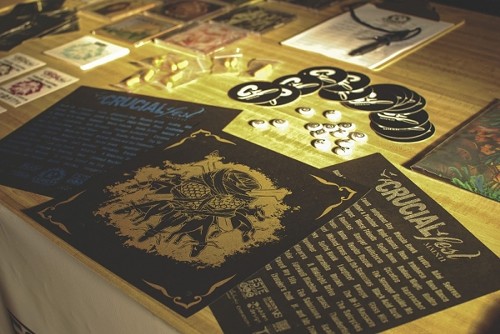Spanish Fork inventor Steve Boynton kept encountering the challenge that faces creatives and innovators in all fields: “lack of funds for prototyping, tooling and, eventually, mass production.”
Boynton is using Kickstarter to try to finance his EarthBaked biodegradable footwear. Though Boynton hasn’t used Kickstarter alone to promote EarthBaked—he’s also reached out via blogs and a Facebook page—Kickstarter has proved ideal for Boynton. “I’ve felt a connection to its thriving community of artists, designers and maker types who now have the ability to bring their projects to market with help from a community of supporters,” Boynton says. “I just don’t feel that same excitement from other crowdfunding platforms.”
More and more Utah creative types are using the popular crowdfunding site Kickstarter to fund their projects. How well is it working for them, and how have different locals adapted it for their purposes in different ways?
Here’s how Kickstarter works: You submit a proposal—which includes the amount you are trying to raise, what you are going to use it for and the time limit in which to raise it—to the staff of Kickstarter.com, who can also provide tips for drafting your proposal. You also submit a short video explaining or illustrating your project. Similar to public-broadcasting fund drives, you provide premiums for differing donation amounts, usually tied in with the project. Typically, filmmakers include supporters’ names in their film’s credits, inventors provide beta versions of their creations, and bands offer CDs and other band swag.
Ideas that otherwise might not be able to get off the ground get “kickstarted” by crowdfunding. It’s democratic in a sense that it allows creators of projects to reach out to people, and provides backers a sense of having invested in things that they truly believe in, at a relatively affordable point of entry.
Among the downsides of fundraising through Kickstarter are the time limit and the all-or-nothing rule. Other crowdfunding, sites like Indiegogo, award all the money pledged regardless of whether the goal is reached, but Kickstarter campaigns are riskier for the artists.
Positive aspects of Kickstarter include the exposure that the popular website provides, the interaction between artists and supporters, and benefits like possibly being selected as one of the staff picks, which garners more attention. Several successful Kickstarters have paved the way for bigger success, like venture capital funding.
If a bunch of artists all donated, say, $25 to one another’s Kickstarter campaigns and all get funded, it’s a wash financially but huge for all of them in terms of support and encouragement. What’s the problem with that? Nothing, except Kickstarter takes 5 percent off the top, in addition to 5 percent to Amazon Payments, which handles the financial transactions. On the other hand, it’s not insular to the arts community; rather, it allows creative types to reach out beyond other artists to the community at large.
Salt Lake City artist Teresa Flowers got the Kickstarter for her Echoes Exhibit 3-D art project off the ground with a launch party, and followed up with a benefit party for backers May 23 at Urban Vintage Antiques in Salt Lake City. This has helped generate enthusiasm for her project. “I can’t believe how much work it takes,” Flowers says. “It is really an amazing experience.”
Jarom Bischoff, owner of Salt Lake City-based Exigent Records and organizer of the Crucialfest music festival, says some of the appeal of the site is about risk management. “All our income comes at the end of the [Crucialfest] festival,” he says. “After six months of planning and investing, it turns out to be a rather large gamble in the end. Kickstarter will help us, hopefully, to get some of that money ahead of time, which will enable us to budget better, negotiate performance agreements more effectively, and take some of the risk out of the equation.”
But a Kickstarter campaign isn’t just something you wind up, and let go. Raising money is hard work, no matter how you do it, and organizing a Kickstarter is a project in itself.
Local filmmaker Clint Wardlow canceled his Kickstarter for The Girls of Artomatic: The Wild Side of Washington D.C. Art two years ago. “I just realized that a Kickstarter campaign took more work than I anticipated,” he says. “Because I was in the middle of editing, I knew I couldn’t devote the time to make it successful. Actually, for the project I am currently working on, we plan a Kickstarter project for the future.
“I think a mistake many folks make is to think an art project will sell itself,” he continues. “There are just so many factors involved, many beyond the control of the artist, that make a project popular or fail, that the key to success is a bit of a mystery.”
In next week’s Part 2, we’ll delve into unraveling the mystery of Kickstarter a bit more, including how to decide whether it’s right for you.
Speaking of Kickstarter
-
Kickstarter Part 2
Is the platform right for your project?
- Jun 3, 2013
-
Currently Kickstarting in February
- Feb 1, 2013
-
Currently Kickstarting in Dec.: Open Orchard Revival, Mideau
- Dec 7, 2012
- More »
More by Brian Staker
-
Live Music Picks: April 12-18
Judas Priest, The Residents, Clownvis Presley, The Breeders and more.
- Apr 11, 2018
-
Loving the Alienation
Helios Creed and Chrome continue making iconoclastic music for outcasts.
- Mar 28, 2018
-
Live Music Picks: March 22-28
U.S. Girls, Ed Schrader’s Music Beat, Hell’s Belles, Columbia Jones and more.
- Mar 21, 2018
- More »
Latest in Arts & Entertainment
Readers also liked…
-
New TV for January 2023
Mayfair Witches, Velma, The Last of Us, Poker Face and more premieres
- Jan 4, 2023



